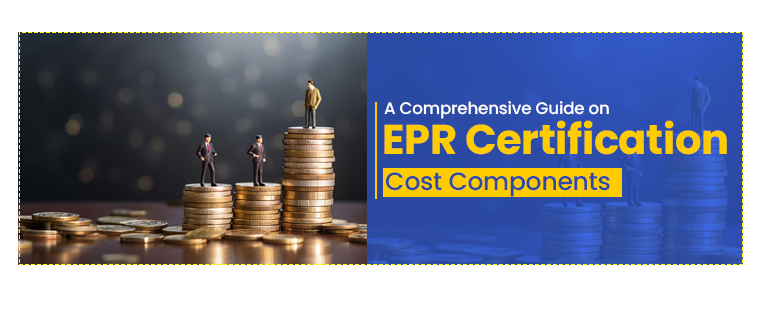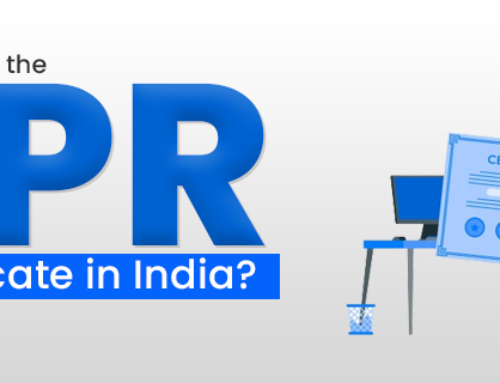As industries worldwide increasingly recognize the importance of environmental sustainability, Extended Producer Responsibility (EPR) certification has emerged as a vital aspect of corporate responsibility initiatives. EPR programs represent a paradigm shift in the way we approach waste management and environmental stewardship by holding producers accountable for the entire lifecycle of their products, from design and production to end-of-life disposal and recycling.
Introduction to EPR Certification:
Contents
- Introduction to EPR Certification:
- Components of EPR Certification Costs:
- 1. Consultation and Assessment Fees:
- 2. Documentation and Reporting:
- 3. Training and Education:
- 4. Audit and Compliance Costs:
- 5. Infrastructure and Technology Upgrades:
- 6. Legal and Administrative Expenses:
- Factors Influencing EPR Certification Costs:
- 1. Industry Sector:
- 2. Company Size and Scope:
- 3. Geographical Location:
- 4. Level of Engagement:
- Conclusion
Extended Producer Responsibility (EPR) is a principle that assigns responsibility for the environmental impact of a product to the producer rather than the consumer. EPR programs are implemented globally to promote sustainable resource management and waste reduction. EPR certification verifies a company’s compliance with relevant regulations and standards, demonstrating its commitment to environmental stewardship.
At its core, EPR embodies the principle of “polluter pays,” whereby producers bear the responsibility for managing the environmental impacts associated with their products. This includes not only minimizing waste generation and pollution during manufacturing but also ensuring proper disposal and recycling once the products reach the end of their useful lives. By incentivizing producers to adopt sustainable practices and invest in recycling infrastructure, EPR programs play a crucial role in promoting circular economy principles and reducing the burden on landfills and natural resources.
Read also this -: How To Get EPR Certificate For Your E waste Management
However, achieving EPR certification involves more than just a commitment to environmental stewardship. It requires businesses to undergo a rigorous process of assessment, compliance, and verification to demonstrate their adherence to EPR regulations and standards. This process incurs various costs, which can vary depending on factors such as the size and complexity of the business, the scope of its product portfolio, and the regulatory requirements in different jurisdictions.
One of the primary components of EPR certification costs is the investment in infrastructure and technology needed to facilitate product recovery, recycling, and disposal. This may include setting up collection and sorting facilities, establishing partnerships with recycling facilities and waste management companies, and implementing tracking and reporting systems to monitor the flow of products throughout their lifecycle.
Additionally, businesses must allocate resources towards staff training and capacity building to ensure compliance with EPR regulations and best practices. This may involve educating employees on proper waste management procedures, implementing quality control measures to ensure product recyclability, and conducting regular audits and assessments to measure performance and identify areas for improvement.
Furthermore, businesses may incur costs associated with third-party certification and verification processes, which are often required to validate compliance with EPR standards and regulations. This may include fees for conducting audits, assessments, and inspections by accredited certification bodies, as well as the cost of implementing corrective actions to address any non-compliance issues identified during the certification process.
While achieving EPR certification is a crucial step towards sustainable business practices, it requires a significant investment of time, resources, and financial capital. By understanding the components of EPR certification costs and proactively addressing them, businesses can better prepare for the challenges and opportunities associated with environmental sustainability compliance in the modern marketplace.
Components of EPR Certification Costs:
1. Consultation and Assessment Fees:
Hiring consultants to assess the company’s current processes and identify compliance gaps is the first step towards EPR certification. Consultants with expertise in environmental regulations and sustainability practices assist in evaluating the organization’s operations, waste management systems, and product lifecycle processes. The fees for consultation and assessment services depend on the scope and complexity of the evaluation, including the size of the organization and the breadth of its product portfolio.
2. Documentation and Reporting:
EPR certification requires extensive documentation to demonstrate compliance with environmental regulations and standards. This includes developing policies, procedures, and records related to waste management, recycling practices, and product life cycle analysis. Companies must create comprehensive documentation outlining their commitment to environmental responsibility and detailing their efforts to minimize waste generation and promote recycling. The costs associated with drafting, reviewing, and maintaining these documents can vary depending on the size and complexity of the organization and the level of detail required for certification.
3. Training and Education:
Ensuring staff awareness and competency in EPR practices is crucial for successful certification. Companies invest in training programs and workshops to educate employees about environmental regulations, waste management techniques, and sustainability best practices. Training initiatives may cover topics such as proper recycling procedures, hazardous waste handling, and compliance with EPR requirements. The costs associated with developing and delivering training materials, as well as employee time spent participating in training sessions, contribute to the overall certification expenses.
4. Audit and Compliance Costs:
Achieving and maintaining EPR certification involves regular audits to assess compliance with relevant standards and regulations. External auditors conduct thorough examinations of the company’s operations, facilities, and documentation to verify adherence to EPR guidelines. The fees for these audits, as well as any corrective actions identified during the audit process, constitute a significant portion of the overall certification costs. Additionally, companies may incur expenses related to internal compliance monitoring and reporting to ensure ongoing adherence to EPR requirements.
5. Infrastructure and Technology Upgrades:
Implementing effective waste management and recycling systems often requires upgrades to existing infrastructure and technology. Companies may need to invest in recycling facilities, waste sorting equipment, and tracking systems to monitor environmental performance metrics. The capital expenditures associated with these upgrades, including equipment purchases, installation costs, and ongoing maintenance expenses, contribute to the overall EPR certification costs.
6. Legal and Administrative Expenses:
Compliance with EPR regulations involves navigating complex legal frameworks and administrative requirements. Companies may incur expenses related to legal consultations, permit applications, and regulatory compliance filings. Legal and administrative costs vary depending on the industry sector and geographical jurisdiction but are essential for obtaining and maintaining EPR certification. Additionally, companies may need to allocate resources for ongoing legal counsel and administrative support to ensure continued compliance with evolving EPR requirements.
Factors Influencing EPR Certification Costs:
1. Industry Sector:
EPR certification costs can vary significantly depending on the industry sector. Industries with high environmental impact, such as electronics, packaging, and automotive, typically face higher certification expenses due to the complexities involved in managing and recycling their products.
For example, the electronics industry must contend with a wide range of materials, including hazardous substances like lead and mercury, which require specialized recycling processes. Similarly, the packaging industry deals with diverse materials such as plastics, paper, and metals, each with its unique challenges in terms of recycling and disposal.
2. Company Size and Scope:
The size and scope of the organization play a crucial role in determining EPR certification costs. Large multinational corporations with extensive product lines and global operations often incur higher expenses due to the scale of compliance efforts.
These companies may need to invest in developing comprehensive EPR policies and procedures, implementing tracking and reporting systems across multiple locations, and conducting extensive employee training to ensure compliance with regulations and standards.
3. Geographical Location:
EPR regulations and enforcement mechanisms vary from one country to another, impacting EPR certification costs for companies operating in different regions. Companies operating in jurisdictions with stringent environmental regulations may face higher compliance costs compared to those in regions with less stringent requirements.
For example, European Union countries have well-established EPR frameworks and strict recycling targets, which may necessitate higher investments in recycling infrastructure and compliance measures. In contrast, companies operating in regions with less developed EPR regulations may face lower certification costs but may also encounter challenges in achieving environmental sustainability goals.
4. Level of Engagement:
Proactive engagement in EPR initiatives and sustainability efforts can help reduce certification costs in the long run. Companies that prioritize environmental stewardship and invest in sustainable practices may benefit from cost savings through improved resource efficiency and reputation enhancement.
Read also this -: How To Register EPR Online And Who Is Required To Do The Registration
By implementing measures to reduce waste generation, increase recycling rates, and optimize product design for recyclability, businesses can lower their overall environmental impact and associated compliance costs. Additionally, proactive engagement in industry-wide EPR programs and partnerships can provide opportunities for cost-sharing and collaboration, further reducing EPR certification expenses.
Conclusion
EPR certification is a critical component of corporate sustainability strategies, demonstrating a company’s commitment to environmental responsibility and regulatory compliance. While achieving EPR certification incurs various costs, investing in sustainable practices can yield long-term benefits, including cost savings, regulatory compliance, and enhanced brand reputation. By understanding the components of EPR certification costs and proactively addressing compliance requirements, businesses can position themselves as leaders in environmental stewardship and contribute to a more sustainable future.






